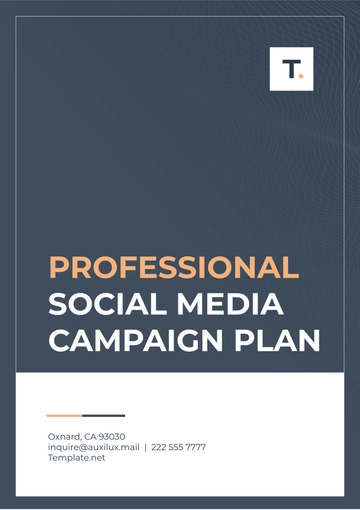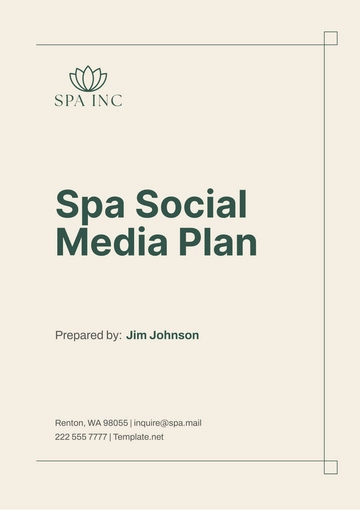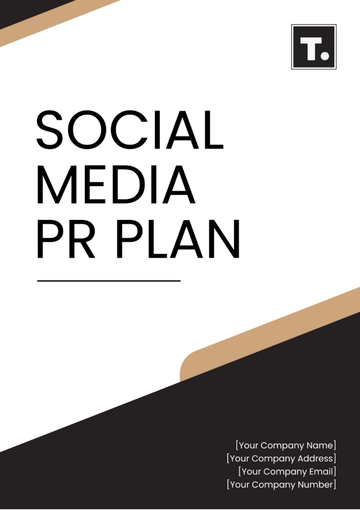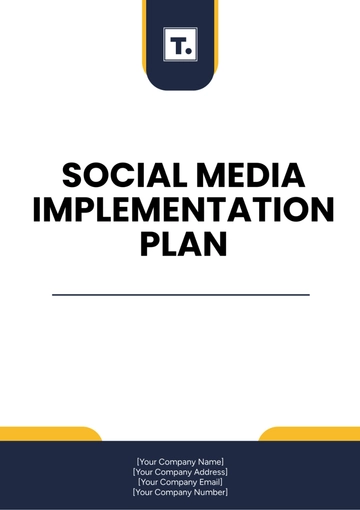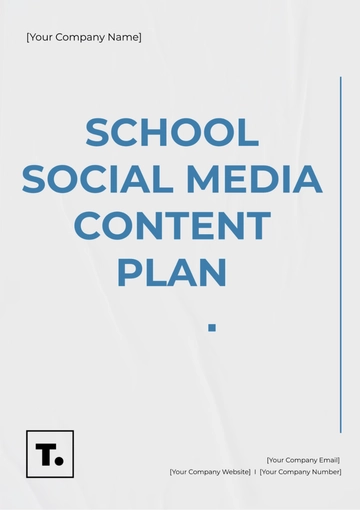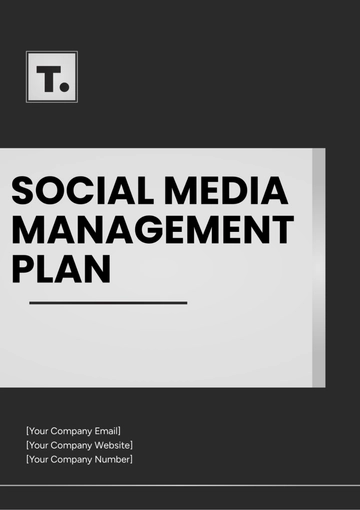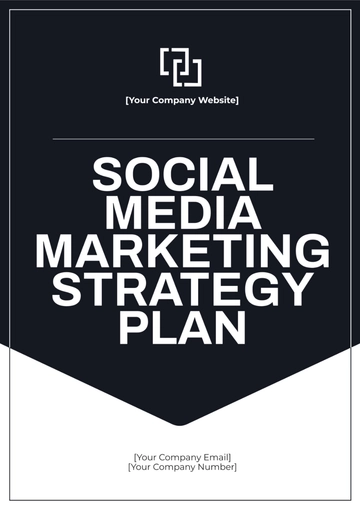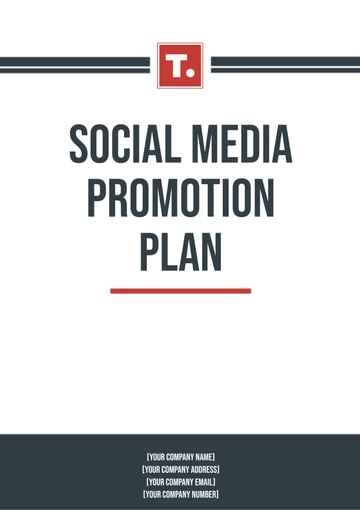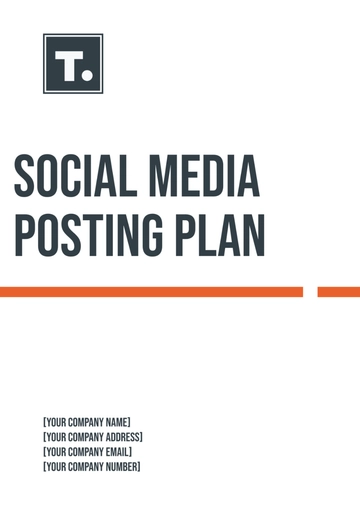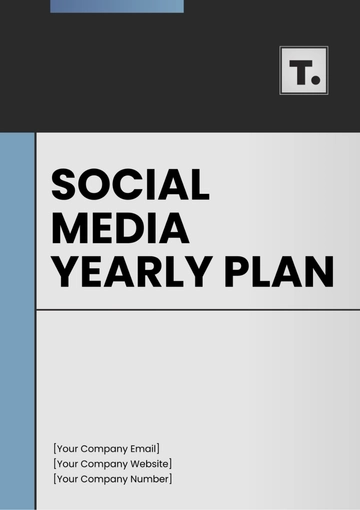Free Cleaning Services Social Media Post Plan
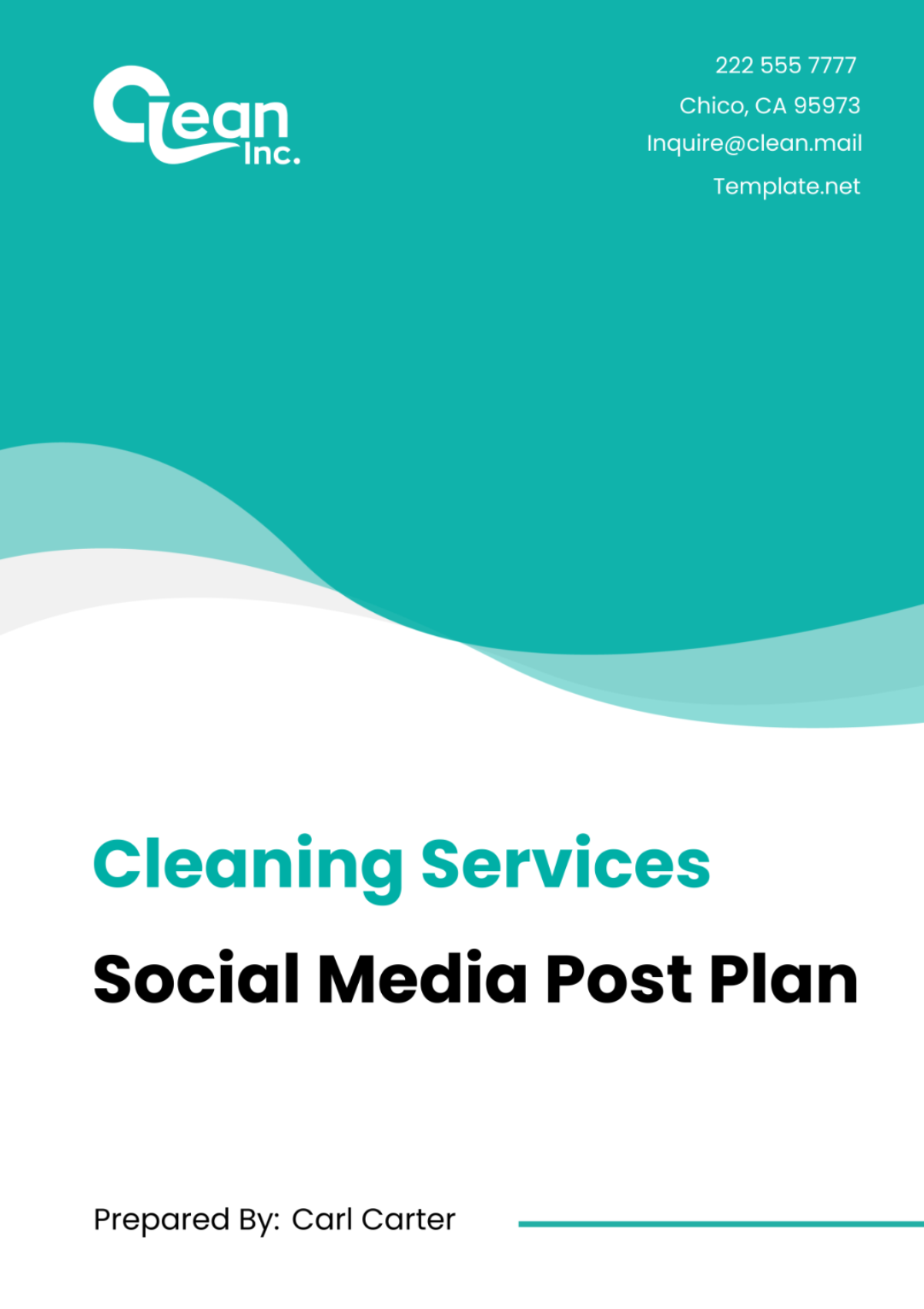
I. Introduction
Welcome to [Your Company Name]'s Social Media Post Plan, designed to elevate our brand's online presence, engage effectively with our audience, and drive business goals through strategic content across platforms like Facebook, Instagram, and Twitter. This document outlines our approach for the upcoming quarter, focusing on key themes, engagement strategies, and performance metrics to ensure our social media efforts contribute to our overall business success.
II. Objectives
Increase Brand Awareness: Aim to grow our social media follower count by 20% over the next quarter.
Enhance Community Engagement: Boost engagement rates by 15%, focusing on likes, comments, and shares.
Drive Website Traffic: Increase traffic from social media by 25%.
Lead Generation: Generate 30 new leads per month through targeted social media campaigns.
III. Target Audience
Audience | Description |
|---|---|
Primary Audience | Homeowners aged 30-55, residing in urban and suburban areas, interested in health, cleanliness, and eco-friendly living. |
Secondary Audience | Small businesses looking for regular cleaning services. |
IV. Content Themes
Process | Description |
|---|---|
Before and After Showcases | Weekly posts featuring transformational cleaning projects. |
Eco-Friendly Cleaning Tips | Bi-weekly posts on using eco-friendly products and methods. |
Meet the Team | Monthly introductions to team members, highlighting their skills and backgrounds. |
Customer Testimonials | Share customer feedback and stories twice a month. |
Special Offers | Promote current discounts or special packages once a month. |
V. Content Calendar (Sample for One Month)
Date | Platform | Theme | Post Details |
|---|---|---|---|
[Date] | Before and After | "Transform your space this spring with our expert team. Swipe to see the magic unfold!" | |
[Date] | Eco-Friendly Cleaning | "Did you know vinegar can work wonders? Here’s how we use it in our eco-cleans." | |
[Date] | Meet the Team | "Meet Maria, our cleaning wizard who’s passionate about making homes sparkle. #TeamSpotlight" | |
[Date] | Customer Testimonial | "Hear from Emily on how our services changed her weekends!" (Include video link) | |
[Date] | Special Offer | "Spring cleaning special! 10% off for first-time clients this month. Book now!" |
VI. Engagement Strategy
A robust engagement strategy is vital for maintaining and growing [Your Company Name]'s online presence. This involves not just broadcasting content, but also actively participating in conversations and fostering community interaction.
Daily Interaction: Dedicate specific hours each day for community management tasks, including responding to comments, messages, and mentions across all platforms. This ensures that your audience feels heard and valued, which is crucial for building loyalty and trust.
Weekly Live Sessions: Use platforms like Instagram and Facebook to host live sessions that can range from Q&A about cleaning techniques, live demonstrations of your services, or simply a casual chat about maintaining a clean and healthy home. These sessions can significantly boost engagement and humanize your brand.
Monthly Contest: Encourage user-generated content through contests, such as a photo competition for the most innovative DIY cleaning hack. Offering incentives, like free cleaning sessions or branded merchandise, can increase participation. Promote winners across your platforms to foster a sense of community achievement.
User Stories Feature: Encourage customers to share their cleaning experiences or results using your services on their stories, tagging your company. Reposting these stories not only validates the customer's effort but also acts as a powerful form of social proof.
Feedback Surveys: Occasionally, use social media to gather feedback on your services or what content your audience would like to see. This not only increases engagement but also provides valuable insights for improving your service offerings.
VII. Performance Metrics
To gauge the success of your social media strategy, it's crucial to track specific performance metrics regularly:
Follower Growth: Monitor the monthly increase in followers to understand brand reach expansion. Setting realistic growth targets can help measure the effectiveness of your content and engagement strategies.
Engagement Rate: Beyond likes, comments, and shares per post, delve into the quality of interactions. Are customers asking questions, giving feedback, or sharing posts? High engagement rates often indicate content relevancy and audience interest.
Website Traffic: Use analytics tools to track how much traffic is directed to your website from social media platforms. Look at metrics like session duration and bounce rate to assess the quality of this traffic.
Leads Generated: Track the number of service inquiries or bookings that come directly from social media platforms. Use dedicated landing pages or tracking links for precise measurement.
Conversion Rate: It’s essential to know not just the leads generated but also how many of these leads convert into paying customers. This metric helps assess the direct ROI of your social media activities.
VIII. Monitoring and Adjusting
Continuous monitoring and adjustment based on performance data ensure your social media strategy remains effective and aligned with your business goals.
Monthly Review Meetings: Bring your marketing team together to review comprehensive analytics, discussing which types of content performed best, engagement trends, and any shifts in audience demographics. Use these insights to identify areas for improvement and to innovate content ideas.
Quarterly Strategy Adjustments: Evaluate the overall strategy every quarter, considering the broader marketing goals and how well they align with your social media performance. Be prepared to shift resources, explore new platforms, or adjust content frequency and type based on these reviews.
A/B Testing: Regularly conduct A/B testing on different aspects of your social media presence, from post times and hashtags to ad formats and content styles. This will provide empirical data on what resonates best with your audience, allowing for more informed decisions.
Training and Development: Based on the reviews and adjustments, identify any skills or knowledge gaps within your team. Invest in training or tools that can enhance their capabilities, ensuring your social media strategy stays innovative and competitive.
By implementing a dynamic engagement strategy, closely monitoring performance metrics, and being prepared to make informed adjustments, [Your Company Name] can effectively use social media to attract and engage customers, ultimately driving business growth.
IX. Expanding the Content Calendar
For a full-fledged content calendar, extend the sample month into a quarterly plan. Diversify the types of content across different days, ensuring a mix that appeals to various segments of your target audience. Incorporate national holidays, seasonal themes, and relevant observances (like National Clean Up Day) to make your content timely and engaging.
X. Detailed Engagement Strategy
Beyond daily interactions and weekly live sessions, consider adding user-generated content features, like a "Fan Photo Friday," where you share customers' cleaning success stories or their use of your tips. Establish partnerships with local influencers or complementary businesses to cross-promote content, expanding your reach.
XI. Comprehensive Performance Metrics
Set specific, measurable goals for each metric. For example, define what a successful engagement rate looks like for your business (e.g., 5% engagement rate per post) and benchmark your follower growth against industry standards or past performance. Use tools like Google Analytics, Facebook Insights, and Instagram Analytics to track these metrics accurately.
XII. Advanced Monitoring and Adjusting
This could include weekly checks of engagement rates and monthly deep dives into analytics. Use this data to identify trends—what types of content perform best, what times are most effective for posting, and how different platforms compare in driving your business objectives. Be ready to shift resources to more successful strategies or experiment with new types of content based on these insights.
XIII. Implementing Feedback Loops
This can be as uncomplicated as enquiring about thoughts and opinions in the comments of your posts or it can be more structured like sending out questionnaires to those who have enlisted themselves in your email list. Use these reactions and comments as a tool to further refine your content, molding it to be a closer match to the wants, likes and requirements of your audience.
XIV. Technology and Tools
List the specific tools and software you will use to create content, schedule posts, monitor engagement, and analyze performance. Consider tools like Canva for design, Buffer or Hootsuite for scheduling, and BuzzSumo for content research and inspiration.
XV. Training and Development
Developing a robust training and development program is essential for ensuring your team is equipped with the necessary skills and knowledge to execute your social media strategy effectively. [Your Company Name] should prioritize continuous learning in social media best practices, platform-specific nuances, and the latest tools and technologies in digital marketing. Here’s how to structure this vital component:
Internal Workshops
Organize monthly internal workshops led by experienced team members or external experts specializing in social media marketing. These sessions can cover a wide range of topics, including:
Content Creation: Techniques for creating compelling and platform-optimized content, including photography, videography, and copywriting skills.
Social Media Algorithms: Understanding how different platforms prioritize and display content, and strategies to maximize organic reach.
Community Engagement: Best practices for engaging with followers, handling negative comments, and building a positive online community.
Online Courses and Certifications
Encourage team members to enroll in online courses and obtain certifications from recognized institutions or platforms such as HubSpot, Google, and Facebook Blueprint. These courses offer in-depth knowledge on:
Digital Marketing Fundamentals: A comprehensive understanding of digital marketing strategies, including SEO, content marketing, and email marketing.
Platform-Specific Advertising: Detailed insights into creating and optimizing ads on platforms like Instagram, Facebook, and LinkedIn.
Analytics and Reporting: Training on how to use analytics tools to track performance, interpret data, and make informed decisions.
Provide support for course fees for courses directly related to their role, and encourage sharing key learnings with the team.
Regular Review Meetings
Schedule bi-weekly or monthly review meetings where team members can present recent campaigns they’ve worked on, share successes, and discuss challenges. This collaborative environment encourages learning from real-world experiences and promotes a culture of continuous improvement. Topics for discussion could include:
Campaign Post-Mortems: Analyzing what worked, what didn’t, and why, for recent campaigns.
Tool Demonstrations: Sharing tips and tricks for using social media management and analytics tools more effectively.
Industry Updates: Discussing recent changes in social media trends, platform updates, and emerging technologies.
Peer-to-Peer Learning Sessions
Foster an environment of peer-to-peer learning where team members can share insights and expertise in informal sessions. This could take the form of:
Lunch and Learn: Casual sessions where team members discuss topics of interest over lunch.
Skill Shares: Team members with particular strengths can offer short training sessions on their areas of expertise, such as graphic design, video editing, or influencer outreach.
Feedback and Personal Development Plans
Incorporate regular feedback sessions focused on personal development within the realm of social media marketing. Work with each team member to identify areas for growth and set goals for skill enhancement. Personal development plans might include:
Targeted Learning Objectives: Specific skills or knowledge areas the team member aims to develop.
Action Items: Steps to achieve these objectives, such as completing a particular course, leading a campaign, or mentoring a newer team member.
Review Schedule: Regular check-ins to discuss progress towards these objectives and adjust the plan as needed.
XVI. Conclusion
As we wrap up the Cleaning Services Social Media Post Plan for [Your Company Name], it's clear that our strategic approach aims to boost our online engagement and showcase the value of our services. This plan leverages various social media platforms to connect with our audience, emphasizing engaging content, robust engagement strategies, and meticulous performance tracking.
Summary of Key Points
Adopted a multi-platform content strategy tailored to our audience.
Focused on engaging content like transformations and eco-friendly tips.
Implemented a strong engagement strategy with daily interactions and live sessions.
Defined key performance metrics for tracking success.
Next Steps and Action Items
To effectively roll out this plan, we'll focus on:
Action Item | Description |
|---|---|
Finalize Content Calendar | Prepare the next quarter's content calendar. |
Team Training | Enhance team skills with workshops and courses. |
Set Engagement Protocols | Establish daily interaction guidelines. |
Implement Performance Tracking | Set up tools for monitoring key metrics. |
Schedule Reviews | Plan regular content and performance review meetings. |
This streamlined approach ensures [Your Company Name] is set to enrich our social media presence, engaging our community and driving growth through strategic and thoughtful marketing efforts.
- 100% Customizable, free editor
- Access 1 Million+ Templates, photo’s & graphics
- Download or share as a template
- Click and replace photos, graphics, text, backgrounds
- Resize, crop, AI write & more
- Access advanced editor
Elevate your social media strategy with the Cleaning Services Social Media Post Plan Template from Template.net. This customizable and editable template is designed with an Ai Editor Tool, and organizes your content calendar, ensuring consistent and engaging online interactions. Ideal for cleaning businesses aiming to boost their social media presence. Craft compelling content effortlessly, only at Template.net.
You may also like
- Finance Plan
- Construction Plan
- Sales Plan
- Development Plan
- Career Plan
- Budget Plan
- HR Plan
- Education Plan
- Transition Plan
- Work Plan
- Training Plan
- Communication Plan
- Operation Plan
- Health And Safety Plan
- Strategy Plan
- Professional Development Plan
- Advertising Plan
- Risk Management Plan
- Restaurant Plan
- School Plan
- Nursing Home Patient Care Plan
- Nursing Care Plan
- Plan Event
- Startup Plan
- Social Media Plan
- Staffing Plan
- Annual Plan
- Content Plan
- Payment Plan
- Implementation Plan
- Hotel Plan
- Workout Plan
- Accounting Plan
- Campaign Plan
- Essay Plan
- 30 60 90 Day Plan
- Research Plan
- Recruitment Plan
- 90 Day Plan
- Quarterly Plan
- Emergency Plan
- 5 Year Plan
- Gym Plan
- Personal Plan
- IT and Software Plan
- Treatment Plan
- Real Estate Plan
- Law Firm Plan
- Healthcare Plan
- Improvement Plan
- Media Plan
- 5 Year Business Plan
- Learning Plan
- Marketing Campaign Plan
- Travel Agency Plan
- Cleaning Services Plan
- Interior Design Plan
- Performance Plan
- PR Plan
- Birth Plan
- Life Plan
- SEO Plan
- Disaster Recovery Plan
- Continuity Plan
- Launch Plan
- Legal Plan
- Behavior Plan
- Performance Improvement Plan
- Salon Plan
- Security Plan
- Security Management Plan
- Employee Development Plan
- Quality Plan
- Service Improvement Plan
- Growth Plan
- Incident Response Plan
- Basketball Plan
- Emergency Action Plan
- Product Launch Plan
- Spa Plan
- Employee Training Plan
- Data Analysis Plan
- Employee Action Plan
- Territory Plan
- Audit Plan
- Classroom Plan
- Activity Plan
- Parenting Plan
- Care Plan
- Project Execution Plan
- Exercise Plan
- Internship Plan
- Software Development Plan
- Continuous Improvement Plan
- Leave Plan
- 90 Day Sales Plan
- Advertising Agency Plan
- Employee Transition Plan
- Smart Action Plan
- Workplace Safety Plan
- Behavior Change Plan
- Contingency Plan
- Continuity of Operations Plan
- Health Plan
- Quality Control Plan
- Self Plan
- Sports Development Plan
- Change Management Plan
- Ecommerce Plan
- Personal Financial Plan
- Process Improvement Plan
- 30-60-90 Day Sales Plan
- Crisis Management Plan
- Engagement Plan
- Execution Plan
- Pandemic Plan
- Quality Assurance Plan
- Service Continuity Plan
- Agile Project Plan
- Fundraising Plan
- Job Transition Plan
- Asset Maintenance Plan
- Maintenance Plan
- Software Test Plan
- Staff Training and Development Plan
- 3 Year Plan
- Brand Activation Plan
- Release Plan
- Resource Plan
- Risk Mitigation Plan
- Teacher Plan
- 30 60 90 Day Plan for New Manager
- Food Safety Plan
- Food Truck Plan
- Hiring Plan
- Quality Management Plan
- Wellness Plan
- Behavior Intervention Plan
- Bonus Plan
- Investment Plan
- Maternity Leave Plan
- Pandemic Response Plan
- Succession Planning
- Coaching Plan
- Configuration Management Plan
- Remote Work Plan
- Self Care Plan
- Teaching Plan
- 100-Day Plan
- HACCP Plan
- Student Plan
- Sustainability Plan
- 30 60 90 Day Plan for Interview
- Access Plan
- Site Specific Safety Plan




